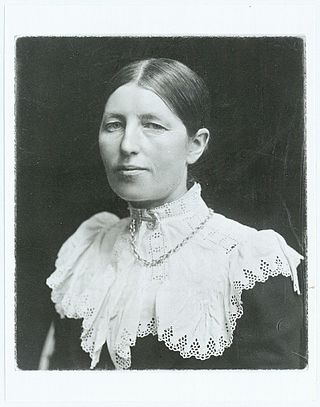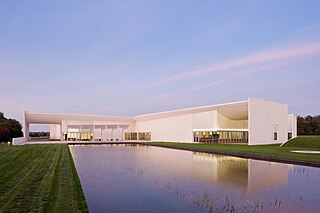
Anna Ancher was a Danish artist associated with the Skagen Painters, an artist colony on the northern point of Jylland, Denmark. She is considered to be one of Denmark's greatest visual artists.

Niels Hansen Jacobsen was a Danish sculptor and ceramist. He is most famous for creating the once controversial sculpture, Trold, der vejrer kristenblod. The name of the statue is taken from a story in Norse folklore where the hero hides in the troll's castle. Thereafter, whenever the troll enters the castle, he cries: "I smell a Christian man's blood!"

Ann Lislegaard is a contemporary artist living and working in Copenhagen, Denmark and New York City, US. She is known for her 3D film animations and sound-light installations often departing from ideas found in science fiction. She finds in Science fiction an alternative approach to language, narration, gender roles and concepts of the future.
Danish art is the visual arts produced in Denmark or by Danish artists. It goes back thousands of years with significant artifacts from the 2nd millennium BC, such as the Trundholm sun chariot. For many early periods, it is usually considered as part of the wider Nordic art of Scandinavia. Art from what is today Denmark forms part of the art of the Nordic Bronze Age, and then Norse and Viking art. Danish medieval painting is almost entirely known from church frescos such as those from the 16th-century artist known as the Elmelunde Master.
Richard Mortensen was a Danish painter.

Esbjerg is a seaport city and seat of Esbjerg Municipality on the west coast of the Jutland peninsula in southwest Denmark. By road, it is 71 kilometres (44 mi) west of Kolding and 164 kilometres (102 mi) southwest of Aarhus. With an urban population of 71,921 it is the fifth-largest city in Denmark, and the largest in West Jutland.

Funen's Art Museum, formerly The Museum of Funen Diocese and Museum Civitatis Othiniensis, founded in 1885, is an art museum in Odense, Denmark. Funen's Art Museum operated as a part of the Odense City Museums.

KUNSTEN Museum of Modern Art is located in Aalborg, Denmark, on Kong Christians Allé near its junction with Vesterbro. Of a modern Scandinavian design, it was built between 1968 and 1972 by Finnish architects Elissa and Alvar Aalto and Danish architect Jean-Jacques Baruël. It was completed on 8 June 1972.

Richard Ludvig Philip Weibull Winther was a Danish artist. He focused on painting, graphics, photography and sculpture. Richard's work was influenced by Asger Jorn and Richard Mortensen, both Danish artists part of the Linien group.
Sonja Ferlov Mancoba was a Danish avant-garde sculptor.
Linien was an artists' association in Denmark in the 1930s and 1940s focusing on Abstraction and Symbolism. The group's exhibitions in Copenhagen created wide international participation. After the Second World War, the association was revived as Linien II with an emphasis on Concrete art.

Randers Museum of Art is a Danish art museum in Randers in northeastern Jutland, Denmark. The museum is located in the cultural centre of Kulturhuset in the town centre and displays many of the major works of Danish painters, especially those of the 19th and 20th centuries.

Vejle Museum of Art in the town centre of Vejle in southeastern Jutland, Denmark has Danish paintings and sculptures from classic modernism up until pre-COBRA on display. The museum is also home to a collection of Golden Age paintings from the Vejle area as well as a collection of drawings, e.g. 50 etchings by Rembrandt.
Palle Louis Nielsen was a Danish illustrator and graphic artist. Considered to be one of the masters of his times, his works include drawings, watercolours, woodcuts and linocuts.
Ib Geertsen was a Danish painter and sculptor. He began as a Naturalist but later turned to Concrete art.

Heart: Herning Museum of Contemporary Art, formerly Herning Kunstmuseum, was founded in Herning, Denmark, in 1976. It opened in 1977 in Angligården, an old shirt factory designed by C. F. Møller. In 2009, it reopened in new premises designed by the American architect Steven Holl.
Lene Adler Petersen is a Danish artist. Her artistic practice is characterized through a continuous collecting, sorting and mixing process of media and techniques and includes happenings and performance art as well as painting, ceramics, drawings, printmaking and installations, film and photography.
Jytte Høy is a Danish contemporary artist whose installations and sculptures consist of simple, everyday materials and objects. From 1996 to 2007 she served as rector of the Jutland Art Academy in Aarhus.

Carl Krull is a contemporary Danish artist. Best known for his "seismic" approach to sculptural drawing and painting, Krull works in various media, including sculptural drawing, sculpture, printmaking, virtual reality, and digital media.

Trapholt is a museum of contemporary art and design located in Kolding, Denmark. It opened in 1988 and was previously named Trapholt Kunstmuseum but its increasing focus on the broader arts lead to its shortened name. It describes itself as a "museum for modern painting, crafts, design, and furniture design".












